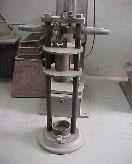AGGREGATE IMPACT VALUE
This test is done to determine the aggregate impact value of coarse aggregates as per IS: 2386 (Part IV) – 1963. The apparatus used for determining aggregate impact value of coarse aggregates is
Impact testing machine conforming to IS: 2386 (Part IV)- 1963,IS Sieves of sizes – 12.5mm, 10mm and 2.36mm, A cylindrical metal measure of 75mm dia. and 50mm depth, A tamping rod of 10mm circular cross section and 230mm length, rounded at one end and Oven.
Preparation of Sample
i) The test sample should conform to the following grading:
– Passing through 12.5mm IS Sieve – 100%
– Retention on 10mm IS Sieve – 100%
ii) The sample should be oven-dried for 4hrs. at a temperature of 100 to 110oC and cooled.
iii) The measure should be about one-third full with the prepared aggregates and tamped with 25 strokes of the tamping rod.
A further similar quantity of aggregates should be added and a further tamping of 25 strokes given. The measure should finally be filled to overflow, tamped 25 times and the surplus aggregates struck off, using a tamping rod as a straight edge. The net weight of the aggregates in the measure should be determined to the nearest gram (Weight ‘A’).

Procedure to determine Aggregate Impact Value
i) The cup of the impact testing machine should be fixed firmly in position on the base of the machine and the whole of the test sample placed in it and compacted by 25 strokes of the tamping rod.
ii) The hammer should be raised to 380mm above the upper surface of the aggregates in the cup and allowed to fall freely onto the aggregates. The test sample should be subjected to a total of 15 such blows, each being delivered at an interval of not less than one second.
Reporting of Results
i) The sample should be removed and sieved through a 2.36mm IS Sieve. The fraction passing through should be weighed (Weight ‘B’). The fraction retained on the sieve should also be weighed (Weight ‘C’) and if the total weight (B+C) is less than the initial weight (A) by more than one gram, the result should be discarded and a fresh test done.
ii) The ratio of the weight of the fines formed to the total sample weight should be expressed as a percentage.
Aggregate impact value = (B/A) x 100%
iii) Two such tests should be carried out and the mean of the results should be reported.
If you have a query, you can ask a question here.



what are uses of determining impact value?
to knowing the impact value less than 50% it is better to use construction,,,if it is >50% that is bad for construction
that will help u to know the strength of the aggregate, whether it should be able to bear the impact of load by vechile or not.
what is the quantity of sample (weight of sample) required for aggregate impact value test?
After compacting the sample in cylindrical cup we will note down it’s weight.
it is approximately 300-320gms.
Can on use the crushing value test in place of the impact value test?. Then is the weight of the hammer for impact value, equal to the force used in crushing value test, which targets 400kN?.
Well done. Please try to provide more information.
It will depends on weighing (balance) machine, some balance is restricted to only 10kg and some other is restricted to 12 kg depending on balance and equipment it will vary, basically it will be chosen from 0.5 kilo gram onwards, whatever the proportion you will be taking, after giving blows to the cylinder you will be measuring its weight(A), after oven replacement you will be taking it out and after impacting the sample again you will be weighing the sample finally whichever passing through 2.36 mm sieve(B), aggregate impact will be = (B/A)*100
Agregate impact value material A is 20 and B is 45. Which one is better for surface course? Why ?
Limits of aggregate impact value
35% -weak for road construction
example of calculation matter of this test
What ae d precautions for aggregate impact ealue
what is good impact value of aggregates?
if aggregate impact value is <10%, 10-20% , 20-30% , 35% then what will be the classification of aggregate ?????
<10%..
Sir, can u say me that if mc metal is there like aggregate size of 40mm or greater than it than how will take sample from 12.5 mm passing and 10 mm retain. weather we crush it if yes than is there any provision for it in IS code
what are the other two test carried out to obtain the strength of aggregates?
correct value 11%
aggregate impact value material A is 20 and that of B is 45 .
which one is better for surface course ?
why ?
Hi.Which one limits is better for concrete course?
what will be the impact test value for d aggregate using in building construction.?
expert in cement and building material design and testing.
What is impact value of stone?